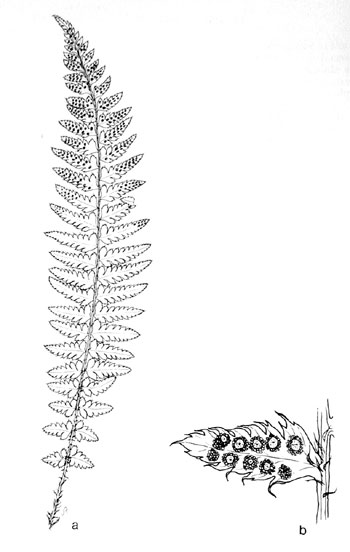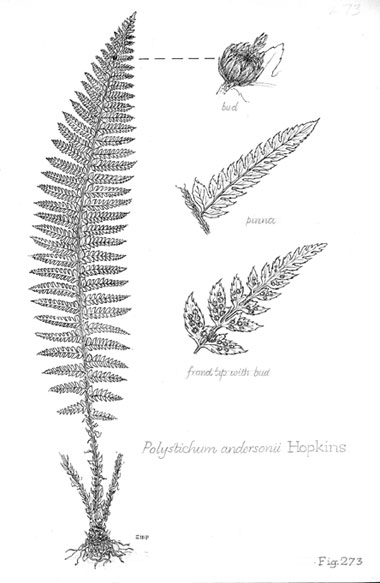|
Hardy Fern Home P. andersonii resources
All Ferns � Dryopteridaceae �� Polystichum
�Other Genera
|
| Polystichum andersonii | ||
Anderson's sword fern | ||
|
Etymology
After Walter Birney Anderson (c1856-1944), collector and Government Inspector of Indian orchards. Collected August 2, 1912 on Vancouver Island, British Columbia.
Description
Rhizome: erect, forms a trunk, trunk clothed in roots.
Frond: 100 cm high by 20 cm wide, evergreen, monomorphic, blade/stipe ratio: 3:1 to 7:1. Stipe: green, grooved, scales dense, light brown, diminishing in size upwards, vascular bundles: 4 or more, in an arc. Blade: 1-pinnate-pinnatifid, lanceolate, base narrowed, bulblet near the tip, glossy, hair-like scales, sparse above, dense below, broader scales on rachis and costa. Pinnae: 18 to 28 pair, first pinnule pair larger, ear-like on lower pinnae, only the upper one larger higher up; pinnules adnate to the costa; margins serrulate-spiny; veins free, forked. Sori: abortive, indusium: . Culture
Habitat: moist forests.
Distribution: Yukon, southeastern Alaska to Oregon, western Montana.
Hardy to -25�C, USDA Zone 5, cool climate required.
Distinctive Characteristics
buds at the tips of fronds
Synonyms
Polystichum braunii (Spenner) F�e subsp. andersonii (M. Hopkins) Calder & Roy L. Taylor Polystichum braunii var. andersonii (M. Hopkins) Hult�n Polystichum jenningsi Hopkins |
|
|
Notes
Parents P. munitum and P. kwakiutlii, the former different in being 1-pinnate, the latter in being fully 2-pinnate and bearing vegetative buds. One is unlikely to confuse P. andersonii with P. kwakiutlii, because it has not been collected since 1940. (from issue 7 of Botanical Electronic News, Adolf Ceska, prop.)
Parents P. munitum and P. kwakiutlii, the former different in being 1-pinnate, the latter in being fully 2-pinnate and bearing vegetative buds. One is unlikely to confuse P. andersonii with P. kwakiutlii, because it has not been collected since 1940. (from issue 7 of Botanical Electronic News, Adolf Ceska, prop.)

Polystichum andersonii. a) frond, b) fertile pinna. �Illustration by V. Fulford from Ferns and Fern Allies of Canada, William J. Cody and Donald M. Britton, 1989, � Agriculture Canada, used with permission. |
